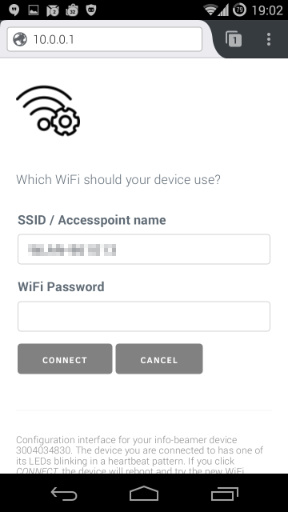Hi there,
We are experimenting different ways of provisionning the raspberry-pi running Infobeamer hosted.
One of our challenges is to manually update Rasberry Pi Zero device that do not have WIFI capacity. Is there a cheat to do this?
One of the present options is to connect the RPI Z as a USB/ Ethernet device by adding the " dtoverlay=dwc2" line in config.txt and the “modules-load=dwc2,g_ether:” line to the cmdline.txt file and use the shared connectivity therewith. So my question is can we just insert those lines in the config files of the infobeamer device or is there a more natural way with infobeamer hosted?
Thx in advance
You mean configuring a WiFi without touching the SD card while at a customer/install location? That’s doable. Have a look at https://info-beamer.com/doc/device-configuration#wificonfigurationinterface
Basically you configure the device beforehand with a WiFi settings. If you don’t know any setting, just use a dummy SSID/password. Then enable the above setting. After 2 minutes trying to use the configured WiFi, the device will open its own WiFi and allow you to reconfigure the settings from any mobile phone (or computer of course).

Thanks for the tip. But actually my request goes further than this.
What I meant was that we have a bunch of devices that run with a Non-WIFI Pi Zero. We are looking at turning these NON-WIFI equipped devices into USB/Ethernet devices that would share our laptop’s connection.
Interesting. But then you’d have to run the Laptop constantly. Wouldn’t it be cheaper to use a Pi version with Ethernet port at that point?
I’ve never tried the gadget mode of the Pi Zero. How do desktop/laptop operating systems usually deal with that? Isn’t that then an unconfigured network devices and you have to manually provide all settings? Or do they provide DHCP (I guess not?) and allow the Pi to route traffic using the desktop/laptop (I would get no again). Seems complicated from a users perspective.
Ok. I’ll try it and post any useful update. I think It might work. If that is successful it will all be about connecting the Non-WIFI RPI Zero with USB and let it share the connectivity for provisionning. Thanks 
I won’t work. If I understood everything correctly after skimming over the documentation, the device will appear as usb0 (instead of eth0 as for normal ethernet). The OS doesn’t handle that.
I’m still not entirely sure what you’re meaning by provisioning’? Even if gadget mode would work: What’s the goal of using it? Configuring the real network parameters? I’m still unsure about the use case of this?
By provisionning I mean downloading assets that need to rotate on the screens, even without any connectivity. I do understand that there is not more that can be done through this type of configuration.
The reasonning behind that is that I do have a stock of RPI Zero from 2015 and wish to use them to build mediaplayers that need to be updated on weekly or monthly basis, by just connecting via a USB to a laptop and use the latter as connectivity source.
It’s all about getting the RPI zero to connect even if it doesn’t have WIFI capabilities.
Hope you realize that info-beamer is an mostly online system. If a device doesn’t have connectivity, it reboots automatically trying restore connectivity. So that’s not something the system was built for.
I do reckon that 
Just trying to open up more options.
It’s surely not about bypassing IB’s platform. I love and trust this platform and respect thee.
The devices would still be registered as normal on the regular IB devices panel. The only thing that might change would be the way content might be updated. Anyways it’s just experimental.
Although not exactly what you are referring to, I required ‘remote access’ to one of my Pi’s whilst operating in a vehicle.
I purchased a TP Link MR200 ( https://www.tp-link.com/in/products/details/cat-5032_Archer-MR200.html ) so I could add content via the Info-Beamer dashboard.
I chose the MR200 as it is open to any 4G network, has ethernet ports and also has detachable antennas in case we need to add an external antenna to the vehicle for better reception.
It also has a WAN/LAN port, so you can share an existing internet connection.
If the assets are ‘shared’ assets, that are also used in setups on other Pi’s, then as far as I’m aware the files only get downloaded one time, and are then shared to the other Pi’s if they are on the same network, which reduces data usage, and is an awesome feature!
1 Like

